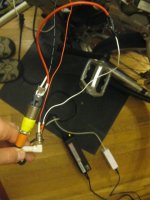veloman said:
...
Why the need for CC/CV?
I ain't John But the need for cc is to guarantee staying at, or below the charge c-rate of the battery, whereas cV sets the final pack charge voltage.
For instance, I use a 500W power supply set at 41.5V to bulk charge my battery packs. The packs use 5000ma 2C-rated battery cells in 3P or 5P configuration, or 6C- 10C capable.
500W is well below the c-rate of the battery packs and 41.5V being the (fixed) voltage, where the battery draws (close to) 0 current when equilibrium (41.5V) is achieved.
So the way I think about it is more along the lines of a cV charger, since 6C-10C is far more current than my power supplies can output.
I can wire my panels in series for 40-something volts. But as I mentioned before, I regularly use intermediate 12V gel-cell batteries powering rc battery chargers
The ability to quickly rewire the panels for series connection and direct pack charging is for those times when things break down, as all things eventually do.
You can get MPPT chargers for lithium cells, but at this time they're pricey... which makes little sense because charging a lithium battery is far simpler than charging a lead-acid, NiCd or NimH cell


